Optimization of the driver drowsiness detection system for basic vehicles
Résumé
Intelligent vehicles can significantly improve the driver's experience and safety, as well as that of other road users. However, the vast majority of current intelligent vehicles, often paired with semi-autonomous or fully autonomous driving capabilities, use powerful algorithms that require extensive connectivity and advanced hardware, which can be costly. This study explores one of the options offered by these intelligent vehicles, specifically the drowsiness detection systems, from a more affordable perspective by using and combining visual and auditory methods. The goal is not only to optimize performance but also to explore the possibilities of adapting such systems for low-end vehicles. For visual detection, we use a camera system, and the images are processed using the Hough Transform or H.T. method, primarily a learning model using Random Forests and the Binary Pattern Run Length Matrix. The cost of the entire system in place and a basic type of vehicle is significantly lower than a mid-range or high-end vehicle offering equivalent features. However, the economic savings can fund other improvements, leading to a system with the same price as mid-range or high-end vehicles but with additional features.
driving behavior, drowsiness detection, intelligent vehicle, low-end vehicle


